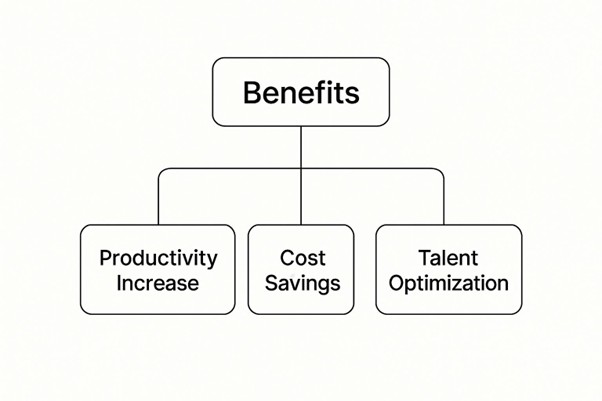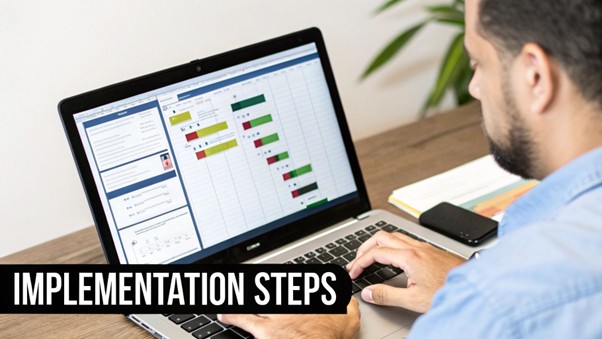Think of workforce planning software as a strategic tool that helps you perfectly align your talent with where your business is heading. It’s all about using data to predict hiring needs, spot skill gaps, and map out organisational changes. The goal? To have the right people with the right skills in the right jobs at exactly the right time.
In This Article
-
-
Why Workforce Planning Software Is Your Strategic Compass
-
Understanding How This Software Actually Works
-
The Core Features That Drive Strategic Decisions
-
How to Gain a Competitive Edge Through Smart Planning
-
Choosing The Right Workforce Planning Software
-
A Practical Guide to Successful Implementation
-
Frequently Asked Questions
Why Workforce Planning Software Is Your Strategic Compass

Trying to steer a modern business without a solid talent strategy is like captaining a ship with no compass. You’re left at the mercy of unpredictable market currents, constantly reacting to problems instead of seeing them coming. This is exactly where workforce planning software steps in, becoming your essential navigation tool. It’s what elevates HR from a back-office function to a core driver of the business.
The fundamental problem this technology solves is huge: it takes the guesswork out of people management. You stop relying on gut feelings for hiring, promotions, and restructuring. Instead, you get a clear, data-driven picture of your entire organisation, empowering you to build a team that’s resilient, agile, and ready for whatever comes next.
Moving from Reactive to Proactive
For too long, many companies have only tackled staffing issues when they become a full-blown crisis—a key person suddenly resigns, or a new project is already behind because it’s understaffed. This reactive scramble is both inefficient and incredibly expensive. Workforce planning software completely flips this model on its head.
It lets you look over the horizon and start asking the right strategic questions, such as:
- What specific skills will we need in two years to hit our growth targets?
- Which of our departments are most at risk of high turnover?
- If we were to merge with another company, how would that impact our current team structure?
By getting answers to these questions ahead of time, you can start building talent pipelines, developing internal leaders, and closing skills gaps before they can slow you down. This kind of foresight is a massive competitive advantage.
“Workforce planning is no longer just about filling roles; it’s about architecting an organisation that can thrive amidst constant change. The right software provides the blueprint to build that future.”
The Growing Demand for Smart Solutions
This shift toward smarter, more strategic talent management is clearly reflected in the market. Take India, for example. The workforce management software market was valued at USD 2,854.5 million in 2022 and is expected to rocket to USD 4,890.7 million by 2029. This isn’t just a trend; it’s a clear signal of the growing demand for solutions that optimise talent and boost productivity. You can dive deeper into these figures in a recent market report about workforce management software in India.
Understanding How This Software Actually Works

So, how does this software really work under the hood?
Let’s break it down. Think of it less like a simple spreadsheet and more like a powerful forecasting engine for your talent. It goes way beyond just tracking headcount. The goal is to give you a strategic view of your entire people ecosystem, answering not just who you have today, but more importantly, who you’ll need tomorrow.
Picture this: you run a retail chain, and the busy festive season is just around the corner. In the past, you might have relied on last year’s numbers and a bit of gut feeling. With workforce planning software, the approach is entirely different. It crunches historical sales figures, employee turnover rates, and even broader market trends to predict exactly how many extra staff you’ll need, right down to the specific stores and the skills they must have to handle the rush.
This isn’t magic; it’s all about data. The software pulls information from all corners of your business—your HRIS, finance systems, CRM, and even external market data. By connecting these dots, it builds a complete picture and runs complex “what-if” scenarios that would be impossible for a human to manage alone.
Bridging Daily Operations with Long-Term Strategy
One of the most common points of confusion is the difference between workforce management and workforce planning. They sound similar, but they operate on completely different timelines. Good software connects them seamlessly.
- Workforce Management (The “Now”): This is all about the day-to-day, the tactical ground game. It covers immediate tasks like employee scheduling, tracking hours, and running payroll. Its main job is to make sure you have enough people to cover this week’s shifts.
- Workforce Planning (The “Next”): This is the strategic, long-term view. It aligns your talent strategy with your business goals three, five, or even ten years down the road. It tackles the big questions: What skills will we need to enter that new market? Who are our future leaders? What should our organisation look like in three years?
Modern workforce planning software is the critical bridge between these two worlds. It takes the real-time operational data from workforce management and uses it to make strategic plans smarter and more realistic.
For example, consistently high overtime hours in one department (an operational metric) is a clear signal that you need to hire more full-time staff there (a strategic decision).
The screenshot above shows a classic strategic workforce planning model. It’s all about forecasting future demand for talent and comparing it against your current supply. The software is designed to pinpoint the gap between what you have and what you’ll need, transforming raw data into a clear roadmap for building a team that’s ready for anything.
This strategic alignment is the core function. The software doesn’t just manage your current team; it architects your future organisation by ensuring your operational actions today are building the strategic capabilities you’ll need tomorrow.
Ultimately, the platform empowers you to stop reacting and start planning. It gives you the insight to not only fill today’s open roles but to proactively build the talent pipelines you’ll need for sustained growth. This forward-thinking approach is what truly separates the market leaders from everyone else.
The Core Features That Drive Strategic Decisions
Good workforce planning software isn’t just one big tool; it’s more like a whole workshop of interconnected instruments. Each one gives you a specific piece of the puzzle, and when you put them all together, you get a crystal-clear picture of your company’s talent landscape. Understanding these core features shows you exactly how the software turns raw data into a real, actionable business strategy.
These tools go way beyond just counting heads. They give you the power to see challenges coming, find opportunities you didn’t know you had, and build a team that’s perfectly lined up with where your business is headed
Demand Forecasting and Supply Analysis
The starting point for any solid plan is figuring out what you’re going to need versus what you already have. Demand forecasting digs into your historical data and business goals to predict your future talent needs. It helps you answer critical questions like, “How many data scientists will we need to launch our new product line next year?”
At the same time, supply analysis takes stock of your current internal talent. It creates an inventory of existing skills, pinpoints your next generation of leaders, and keeps an eye on metrics like attrition rates. By putting the forecasted demand right next to the current supply, the software instantly shows you the gaps you need to start working on.
Let’s break down the most impactful features and see how they translate into tangible business benefits. This table outlines the core functionalities and their strategic value.
Key Features of Workforce Planning Software and Their Business Impact
| Feature | What It Does | Strategic Business Benefit |
| Demand Forecasting | Uses historical data and business goals to predict future talent and skill requirements. | Enables proactive hiring and development, ensuring you have the right people ready for future projects and growth. |
| Supply Analysis | Maps out the current workforce’s skills, roles, potential, and flight risks. | Identifies internal talent for promotions, highlights retention risks, and provides a clear picture of your current capabilities. |
| Skills Gap Analysis | Compares the skills needed for future roles against the skills your current employees have. | Allows for targeted upskilling programmes and precise hiring, reducing recruitment costs and boosting internal mobility. |
| Scenario Modelling | Simulates the workforce impact of potential business decisions (e.g., M&A, budget cuts). | Empowers leaders to make data-backed decisions with a clear understanding of costs, risks, and talent implications beforehand. |
As you can see, each feature provides a layer of insight that moves your organisation from being reactive to truly strategic in how it manages its people.
Skills Gap Identification
Knowing you need ten more project managers is useful. But knowing you need ten project managers with specific certifications is a game-changer. That’s what skills gap analysis delivers. Modern workforce planning software can map the skills of your current team against the precise skills needed for future roles.
This unlocks some incredibly focused talent strategies. Instead of defaulting to external hiring, you can now:
- Roll out targeted training programmes to upskill your existing employees.
- Design clear internal career paths to move your high-potential people into new roles.
- Sharpen your hiring criteria to attract candidates with the exact skills you’re missing.
This level of detail helps you build capabilities from within, which cuts down on hiring costs and boosts employee retention. In a fast-moving market, having a clear inventory of your skills is essential to staying ahead. You can see more on how tech is changing the game by exploring how a modern recruitment platform eases digital hiring.
The image below shows the direct line between leveraging these features and seeing real business results.

This really brings home how optimising your talent leads directly to bottom-line improvements in both cost and productivity.
Scenario Modelling and Simulation
Scenario modelling is perhaps the most powerful feature of all. Think of it as a flight simulator for your biggest business decisions. It lets you model how different business scenarios might impact your workforce, all without any of the real-world risk.
Scenario modelling transforms workforce planning from a reactive exercise into a strategic wargame. It allows leaders to test hypotheses, anticipate outcomes, and make data-backed decisions with confidence before committing significant resources.
For instance, you could run a simulation to see the workforce fallout from:
- A potential merger or acquisition.
- Opening a new office in another region.
- A 15% budget cut across certain departments.
By running these “what-if” scenarios, you get a clear view of the potential costs, restructuring needs, and talent gaps tied to each decision. This is the capability that elevates workforce planning software from a simple HR tool to a strategic asset for the C-suite, paving the way for proactive and well-informed leadership.
How to Gain a Competitive Edge Through Smart Planning

Putting workforce planning software in place is about much more than just a simple efficiency boost. It’s about building a fundamentally more agile and competitive organisation from the ground up. This technology connects your talent strategy directly to your business goals, turning abstract objectives into tangible, measurable wins.
Instead of just vaguely “improving efficiency,” you can now slash hiring costs by proactively identifying internal talent for future roles. This massively reduces your reliance on expensive, last-minute recruitment drives. It’s a strategic shift that changes how you manage your single biggest expense—your people—moving from reactive spending to proactive investment. This ensures every rupee you allocate to your workforce delivers the maximum possible value.
Optimise Labour Costs and Boost Agility
Good workforce planning software gives you a crystal-clear line of sight into your labour costs. You can model different staffing scenarios to see exactly how business decisions will impact your budget before you commit a single rupee.
Imagine a manufacturing company trying to decide between adding a third shift or simply paying overtime. With this software, they can simulate the cost impact of both options, making a data-driven choice that protects their bottom line.
This kind of foresight is what creates true organisational agility. When market conditions shift unexpectedly, companies with a solid workforce plan can pivot in a heartbeat. They already know where their talent is, what skills they have, and how to redeploy teams to meet new demands without missing a step.
By analysing metrics such as employee turnover rates, demographic changes, and skills gaps, companies in healthcare, manufacturing, and retail sectors in India leverage workforce planning tools to ensure the right-sizing of staff and compliance with regulatory requirements. This growth is propelled by the need for flexible strategies that can adapt to market volatility.
Improve Retention and Secure Your Leadership Pipeline
Beyond just the numbers, smart planning has a profound impact on your people. When employees can see clear, data-informed career paths within the organisation, their engagement and loyalty go through the roof. The software helps you spot high-potential individuals and map out their growth trajectories, proving to them that they have a real future with your company. That transparency is a powerful retention tool.
This same data also fuels a rock-solid succession plan. You can identify critical leadership roles and pinpoint potential internal successors long before a vacancy even appears. By tracking their development and readiness, you ensure a smooth transition and secure your organisation’s leadership for years to come. This approach, which turns talent management into a genuine competitive advantage, is also crucial when considering how Indian IT companies are reducing workforce expenses.
Choosing The Right Workforce Planning Software
Picking the ideal workforce planning software can feel like a massive undertaking, but breaking it down into a structured process makes it far more manageable. The first, and most critical, step is to look inwards and get an honest picture of your organisation’s real needs and where you are on your planning journey. A fast-growing startup has completely different requirements than a large, established enterprise that’s looking to fine-tune its existing structure.
Start by creating a “must-have” feature list. Don’t do this in a silo—pull in key stakeholders from HR, finance, and IT. Getting their combined perspectives ensures the platform you choose solves genuine business problems, not just challenges within a single department. This collaborative list will become your scorecard for sizing up potential vendors.
Core Evaluation Criteria
Once you have a clear understanding of your internal needs, you can start looking at what the software can actually do. It’s easy to get distracted by flashy features, so stay focused on the fundamentals that will deliver real, long-term value. Your evaluation should zero in on four critical areas:
- Integration Capabilities: How well will the new software play with your existing HRIS, payroll, and finance systems? Seamless integration isn’t just a nice-to-have; it’s essential for creating a single, reliable source of truth for all your people data.
- Scalability for Growth: The software you choose today has to be ready for where your organisation is headed tomorrow. Can it handle a jump in employee numbers, expansion into new markets, or more complex organisational charts down the line?
- User Experience (UX): Let’s be frank: if the software is clunky or a pain to use, your teams simply won’t adopt it. A clean, intuitive interface is vital for managers and HR professionals to get the full benefit of its powerful features.
- Analytics and Reporting: The real magic of this software lies in the insights it unlocks. Dig into the quality of its dashboards, the customisation options for reports, and its ability to turn mountains of data into clear, actionable recommendations for your leadership team.
The Rise of AI and Cloud Platforms
Looking at the market today, it’s clear that intelligent, cloud-based solutions are leading the pack. These platforms offer huge advantages in flexibility, cost-effectiveness, and predictive power. Cloud deployments, in particular, are completely changing the game.
Cloud-based workforce management solutions are rapidly becoming dominant in India, addressing key challenges of scalability and cost. Globally, these deployments now account for approximately 65% of software revenue in this space, driven by lower infrastructure costs and better support for hybrid work models.
What’s more, the integration of Artificial Intelligence (AI) takes these platforms to the next level by sharpening demand forecasting and optimising schedules. This can translate into a 25% reduction in overtime costs and a massive 30-40% drop in payroll errors. You can dive deeper into the data on these market trends and their impact on Mordor Intelligence.
Ultimately, choosing a platform that embraces these modern technologies is an investment in a future-proof solution that will grow right alongside your organisation.
A Practical Guide to Successful Implementation
Let’s be honest: the most powerful workforce planning software on the market is only as good as its implementation. Just buying the technology isn’t the finish line; it’s the start of the race. Turning that investment into a genuine strategic advantage requires a smart, human-centric approach to change. This means looking beyond the technical setup and focusing on your people, processes, and data right from day one.
A successful rollout actually starts long before anyone installs a thing. Your first job is to get your executive team on board with a rock-solid business case. Don’t frame this as an HR expense. Instead, present it as a strategic tool for optimising your single largest cost centre—your people. You need to show the decision-makers exactly how it will deliver real results, like lower hiring costs, better business agility, and a stronger leadership pipeline for the future.
Building Your Implementation Team
Next up, you need to assemble a cross-functional team. This can’t be just an HR project. You absolutely need key players from finance, IT, and your core business operations at the table.
Getting this diverse group involved early ensures the implementation lines up with the company’s bigger goals. It also means you tackle all the technical and financial hurdles from the get-go. This team will become the champions for the new system, driving adoption in their own departments.
Once your team is in place, it’s time to focus on the foundation: your data.
- Data Cleansing: Before you even think about migrating anything, get your existing HR data in order. Make sure it’s clean, accurate, and consistent across the board. Inaccurate data is the number one reason these projects fail.
- Process Mapping: Take the time to map out your future workforce planning processes. How will managers make requests? Who needs to sign off on them? Getting these workflows clear before you configure the software will save you a world of headaches later.
- Phased Rollout: Don’t try to boil the ocean. Kick things off with a pilot programme in one department. This gives you a safe space to iron out any kinks before you launch it across the entire company.
Driving Adoption and Long-Term Success
Finally, you have to remember that implementation isn’t a one-time event. It’s an ongoing process. Your communication and training plan is absolutely critical here. Be crystal clear about the “why” behind this change and provide hands-on training that’s tailored to different users, from your HR admins to the line managers who will use it every day.
Effective implementation treats workforce planning as a continuous business discipline. The software is the engine, but your people, data, and processes are the fuel that powers it towards sustainable strategic alignment.
To really get the most out of your new system, it’s also smart to think about how it can support other modern talent strategies. For instance, for companies looking to scale their hiring in a smart, efficient way, understanding the principles of digital RPO for high-impact hiring can provide invaluable context. When you pair intelligent software with effective recruitment strategies, you start building a truly resilient and forward-looking organisation.
Frequently Asked Questions
As you start to explore this technology, a few common questions always pop up. Getting straight answers is the best way to make sure you’re making a smart call for your organisation.
1. How Is This Different From Our HRIS?
It’s a great question, and the distinction is crucial. Think of your HRIS (Human Resource Information System) as the official record of your team right now. It’s brilliant at managing payroll, benefits, employee data, and all the day-to-day HR functions. It’s your system of record.
In contrast, workforce planning software is your strategic crystal ball for the future. It pulls data from your HRIS and other business systems to forecast your talent needs, model different business scenarios (like a new product launch or market expansion), and spot critical skill gaps long before they become a problem. One manages the present; the other helps you architect the future.
2. Is This Software Only for Large Enterprises?
Not anymore. It’s true that in the past, only massive corporations had the budget and resources for this kind of strategic tool. But modern, cloud-based solutions have completely changed the game, making them scalable and affordable for small and medium-sized businesses (SMBs) too.
For an SMB, this software can be a massive competitive advantage. It lets you make smarter hiring decisions, get a handle on labour costs, and ensure you have the right people in the right seats to drive your growth.
The best platforms deliver value right from day one, even with just your basic HR data. The insights only get richer and more powerful as you begin to connect other data sources over time, like sales pipelines or project roadmaps.
3. What Kind of Data Do We Need to Get Started?
You can get going with the foundational data you almost certainly have in your HR systems already:
- Employee headcount
- Job roles and departments
- Turnover rates
- Compensation details
Honestly, the most important first step isn’t having massive amounts of data—it’s making sure the data you do have is clean and accurate. Once that solid foundation is in place, you can start integrating other business data to make your forecasting even more powerful.
Ready to align your talent strategy with your business goals? Taggd offers expert Recruitment Process Outsourcing to help you build the workforce of the future. Discover how we can help.
 />
/>





